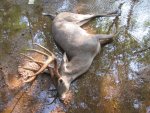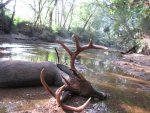zachdawg
Senior Member
: Has anybody heard of black tongue disease. A buddy told me it has hit Franklin Cty pretty hard this year. Says that they have found tons of deer laying beside creeks and ponds dead, and it makes sense cause we are just not seeing 1/2 the deer we did last year.
Has anybody heard of black tongue disease. A buddy told me it has hit Franklin Cty pretty hard this year. Says that they have found tons of deer laying beside creeks and ponds dead, and it makes sense cause we are just not seeing 1/2 the deer we did last year.
 Has anybody heard of black tongue disease. A buddy told me it has hit Franklin Cty pretty hard this year. Says that they have found tons of deer laying beside creeks and ponds dead, and it makes sense cause we are just not seeing 1/2 the deer we did last year.
Has anybody heard of black tongue disease. A buddy told me it has hit Franklin Cty pretty hard this year. Says that they have found tons of deer laying beside creeks and ponds dead, and it makes sense cause we are just not seeing 1/2 the deer we did last year.


